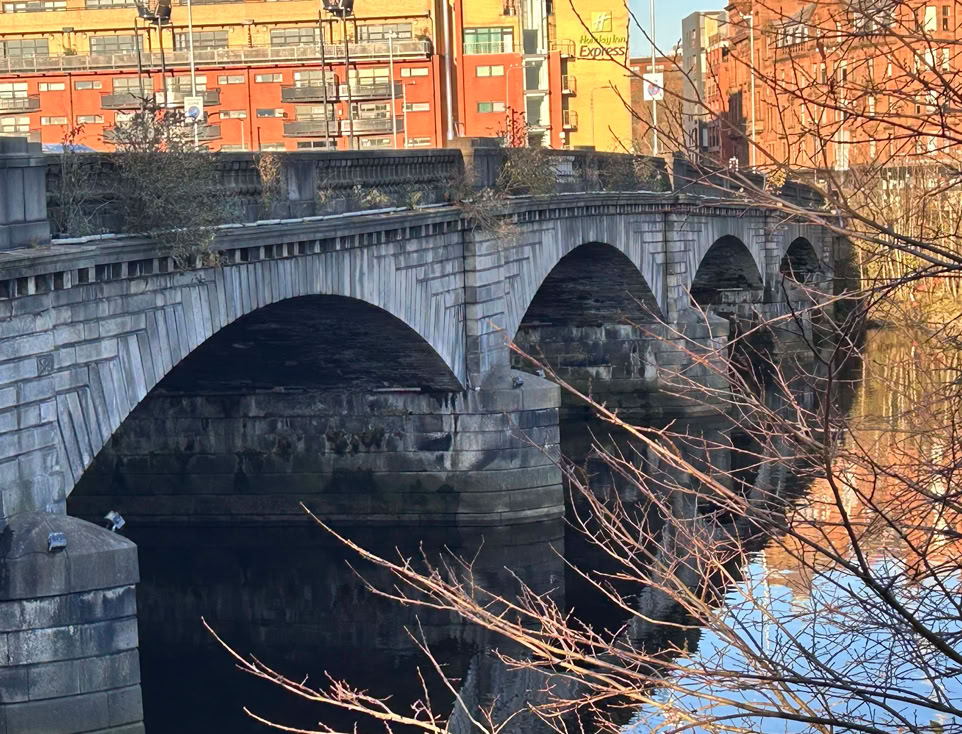Glasgow Old Bridge.

A bridge at Glasgow was known of in the late 13th century. A Paisley Abbey charter of 1285 mentions the Pontem de Clud, and according to Barbour’s 15th century poem (Ref) this bridge was wooden (“a bryygt made of tre”). Tradition is that a completely stone structure replaced the wooden bridge in 1345, built by William Rae who was Bishop of Glasgow from 1339 to 1367. The Bishop’s bridge linked the Barony of Gorbals with the city. Gorbals belonged to the see of Glasgow from the 13th century apart from the small section of Bridgegate which was owned by the Campbells of Lochow. The widow, Marjory, Lady Lochow is said to have assisted in the building, contributing the cost of one arch along with the Bridgegate land on the south bank. A statue bust of a lady was said to be embedded in one of the arches. There is a problem with this story: the attributed Marjory, Lady Lochow was born in 1375, 30 years after the build date, and furthermore, she was never a widow. Could the auxiliary benefactor have been the earlier Helena of Lennox, wife of Colin Cambell, Lord Lochow? Helena, Lady Lochow was indeed widowed, and died in 1347. Alternatively, the bridge may have been built by a later bishop. Bishop Wardlaw, succeeded Bishop Rae, and died in 1387 . Bishop Glendonwyng followed, and died in 1408.
Throughout the centuries, it was called The Great Bridge or Old Stockwell Bridge. Fishergate along with Bridgegate was at its north end. Fisherman drew their water supplies from a wooden (stock) well which gave its name to Stockwell St. At the time of William Roy’s survey, in 1750, Glasgow still had only a single bridge crossing the Clyde. It was not until 1771 that the city acquired a second bridge at Jamaica St.
The old Bishop’s Bridge had eight arches and was gently humped. The decking was 12 feet wide and it was a little over 400 feet long. Some paintings seem to show pointed arches of variable-span (Link), yet others depict stilted segmental arches of fixed-span (Link). The central arch appears to have been around 35 ft. wide. The bridge would have been a defining landmark of the city until the eighteenth century. In 1618, it was described as “ane of the most remarcable monuments within this kingdome”.
In 1571, James VI awarded rights to impose a toll. This was to raise funds because the bridge had been damaged by “great trowpes of ice”. In 1581, there was a leper hospital at the south end. In a charter of 1598, it was described as ‘much decayed’ and ‘pillars, pend and under-props being so shaken and brugille by the inundation force’. Stones were falling off in 1658, and carts were required to have the wheels removed while crossing in order to prevent damage to the decking. In 1671, on the day of the Glasgow Fair, one arch fell. This was rapidly repaired by public subscription. In 1776, instability and risk of flooding required the two most northerly arches to be filled-in and the bank narrowed to incorporate them. The bridge was also widened to 22ft. In 1821, Thomas Telford was contracted to further widen it to 34 ft with iron footpaths on either side. It was now 500 years old and was becoming unsafe. Scouring had eroded the piers which had to be underpinned by piles. An odd artificial platform supported the arches which was always at risk of being swept away. Jamaica Street’s Glasgow Bridge was now the main crossing for traffic.
In 1850 the bridge trustees and the Town Council petitioned for an Act of Parliament to dismantle and remove the entire structure. Curiously, during the demolition a smooth decking was uncovered right down on to the arches. It seems that at some lengthy period in its history there had been no infill or spandrels on the eight arches implying a bumpy crossing. Even more surprising was the state of the foundations; oak branders were uncovered; they were found to be 'as fresh as when first put in’ despite being more than 400 years old.
In 1851, Victoria Bridge was built as a replacement. It too was impressive for its time. At fifty-four feet wide, it was briefly the widest bridge in Britain. Beautifully built in Dublin granite ashlar with balustraded parapets, its five stilted segmental arches lie on enormous piers which themselves are underpinned by steam-driven wooden piles penetrating 20ft below the river bed.

Page last updated Jul’24